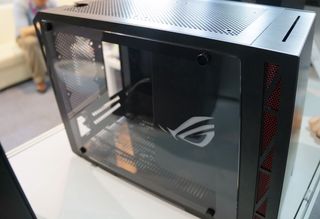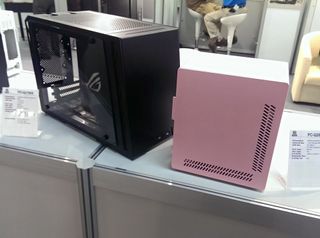Lian Li's PC-Q17 is an ROG modification of the NCase M1

There are cases upon cases upon cases at Computex, but Lian Li’s PC-Q17WX was the first to catch my attention with history first, looks second. Which isn’t to say the case is ugly—it’s just that the story behind it is even more interesting.
This classy mini-ITX case is actually a modification of the Lian Li-manufactured NCase M1, which was crowdfunded in 2013 by a small community of dedicated case enthusiasts. A pair of [H]ardForum members came up with the design for what they wanted out of a small form-factor case: flexible cooling and storage options and aluminum over plastic. Now, two years later, the base design of the M1 has been modified by Asus’ Republic of Gamers engineers to become a new case, the PC-Q17WX.
The PC-Q17WX has room for four 3.5-inch HDDs and six 2.5-inch HDDs/SSDs, despite being a mini-ITX case. It can also hold a 270mm graphics card (Nvidia’s 900 series reference cards measure 266mm), 140mm tall CPU cooler, and full-size 150mm ATX power supply. More significantly, it has room for dual rear 80mm fans, a 120mm and 140mm fan at the top of the case, and two 120mm fans at the bottom.
While it’s hard to tell in the photo above, the front of the case has been redesigned with a shallow wedge. The power button and USB 3.0 ports sit at the bottom of the wedge. It’s easier to tell that the case is accented with some RoG flair and a very reflective glass window panel, probably its biggest differentiator from the solid NCase M1.
You can buy the NCase M1 for $185, but I don’t know how much the new PC-Q17 will cost. Lian Li says it will be available in the next few months, but a final price won’t come until they put the finishing touches on it. Of all the small form-factor mini-ITX cases I saw at Computex, this one may have been my favorite: what looks like a very nice mix of flashy and build flexibility in a compact frame.

The biggest gaming news, reviews and hardware deals
Keep up to date with the most important stories and the best deals, as picked by the PC Gamer team.

Wes has been covering games and hardware for more than 10 years, first at tech sites like The Wirecutter and Tested before joining the PC Gamer team in 2014. Wes plays a little bit of everything, but he'll always jump at the chance to cover emulation and Japanese games.
When he's not obsessively optimizing and re-optimizing a tangle of conveyor belts in Satisfactory (it's really becoming a problem), he's probably playing a 20-year-old Final Fantasy or some opaque ASCII roguelike. With a focus on writing and editing features, he seeks out personal stories and in-depth histories from the corners of PC gaming and its niche communities. 50% pizza by volume (deep dish, to be specific).
Most Popular

